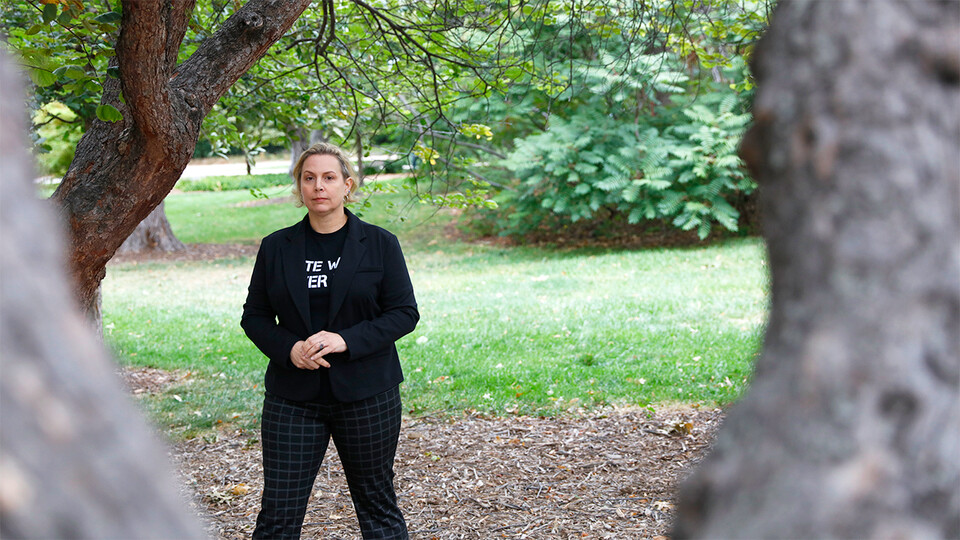· 5 min read
Research Roundup | Nov. 14

Welcome to the Research Roundup: a collection of highlights from the latest Husker research and creative activity.
Pickin’ up good vibrations
In the United States, almost one-fifth of commercially raised piglets die in the roughly three weeks following birth — the period during which a litter nurses from its mother before being weaned off her milk. Farmers and researchers are collectively investigating how to better monitor sows and their litters for the sake of reducing that mortality rate. Though effective, video monitoring requires proper lighting, along with digital processing and storage capabilities, that make it difficult to implement on a wide scale. Wearable sensors, meanwhile, contend with the challenges of durability, battery life and other issues.
Nebraska’s Tami Brown-Brandl, Raj Sharma and Asya Macon, all from the Department of Biological Systems Engineering, partnered with colleagues at the University of Michigan, Stanford University and Carnegie Mellon University to explore another option. The team placed sensors on the undersides of several pens to test whether vibrations could help identify a sow’s posture — lying vs. sitting/kneeling vs. standing — and the feeding activity of both the sow and her piglets.
With the aid of machine learning, the vibration-sensitive system accurately classified a sow’s posture in the vast majority of cases: 95.5% of sitting/kneeling, 99.9% of lying and 100% of standing. It also correctly classified a sow’s feeding 96% of the time and pegged piglet nursing 91.3% of the time.
The findings suggest that vibration sensors could prove a reliable, practical way of flagging the factors — piglet size and illness, sow-induced injuries — that tend to put piglets at risk.
Get the blood flowing
Peripheral artery disease stems from the narrowing or plaque-related blockage of blood vessels, which limits the flow of blood to the extremities, usually the legs. Though the resulting lack of oxygen can lead to periodic pain in the legs, peripheral artery disease can also develop without pain, delaying treatments and potentially yielding more severe long-term health issues. And diagnosing peripheral artery disease can be especially difficult among older adults, who sometimes suffer from health problems with symptoms similar to those of PAD.
Unfortunately, the go-to diagnostic procedure for PAD is expensive and requires specialized training. Nebraska Engineering’s Fadi Alsaleem, Mohammad Ali Takallou and Ali Hazem Al Ramini contributed to a recent study aimed at developing an easier, less costly screening technique. Led by the University of Nebraska at Omaha, the study applied machine learning to data collected from 270 adults — 227 with PAD, 43 without — who walked a path lined with force-measuring plates while wearing reflective markers captured by high-speed cameras.
By identifying certain biomechanical and pressure-related signatures, two types of machine-learning models successfully distinguished between adults with and without PAD in about 89% of cases. Even when relying only on so-called ground reaction forces — the forces exerted on a foot when a foot applies force to the ground — one of the model types still achieved 87% accuracy.
Applying the study’s proof-of-concept to wearable sensors, including those integrated into shoes, could eventually help alert physicians to the onset of PAD, the team said.
Survey says…
In late 2020, the university’s Bureau of Sociological Research surveyed a random sample of 2,775 Nebraskans. The survey arrived amid the aftershocks of two seismic events: the onset of the COVID-19 pandemic and nationwide protests over the murder of George Floyd by a former Minneapolis police officer.
As a researcher who has studied the intersections among public health, crime, policing and politics, the Department of Sociology’s Lisa Kort-Butler decided to analyze those survey results. She was especially interested in whether general anxieties and insecurities spurred the ongoing discord might be influencing attitudes toward public policy and those in authority.
Perceiving COVID-19 as a serious threat, regardless of whether that threat was considered an economic or health problem, corresponded with worrying more about crime. And Nebraskans who viewed COVID-19 as a health threat were also more likely to avoid areas where they felt unsafe. But those knowing someone who had contracted COVID-19 were actually less likely to avoid those areas — a seemingly paradoxical finding that nevertheless echoed national surveys.
Roughly 20% of respondents said their communities were spending too little on law enforcement. According to the survey, Nebraskans who believed so generally also:
- Perceived COVID-19 as more of a threat to the economy than to public health
- Expressed trust in political leaders, but a distrust of health officials, on matters related to COVID-19
- Believed that race relations in the United States were worsening
Overall, Kort-Butler said, the survey data supported the idea that the uncertainty and insecurity arising from periods of upheaval can get channeled into support for criminal justice policies that promise a return to normalcy.












